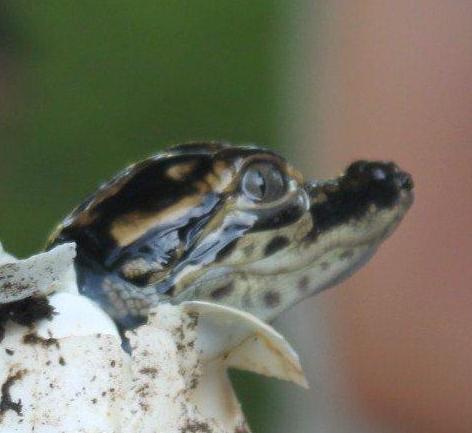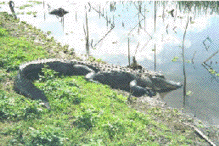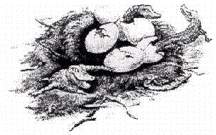 |
|
 |
-
Home - Park
Information - Programs,
Activities & Hikes - We've
Got Gators - Plants &
Animals - Get
Involved -
Members -

AlligatorsMore Facts |
|
King of the wetlands and the largest predator in the park, the American Alligator dominates the wetland ecosystem. Alligators and other reptiles such as turtles are cold-blooded. This means that they cannot control their own body temperatures and must use the warmth of the sun as fuel for energy. Alligators, snakes and turtles can often be seen basking on the banks or floating logs. They seldom move during this process of "collecting energy" so it is important that we do not disturb them. If you see a basking alligator with its mouth open it is cooling off its body, much like the panting of a dog. The only other time it may open, its mouth is to warn you that you are too close. It may also hiss at you! Alligators often move from one body of water to another so you may see an alligator crossing a trail. A good way to estimate the length of an alligator whose body is not totally exposed above or out of the water is to estimate the distance in inches between the bump of its eye and the bump of its nose. Then convert that number into feet. For example, if you guess that there is 6 inches between the nose and eyes then the alligator is probably about 6 feet long
Mating season begins in late March and lasts until the end of May. You may hear deep bellows coming from the lakes. This is the mating call of the male alligator. (Not to be confused with the call of the male bullfrog which has inflection and is repeated consecutively). You may also hear or witness head slapping in the water. Male alligators are very territorial during this time and sometimes challenge each other for territory or female partners. Males will mate with many different females and the mating actually occurs underwater accompanied with unusual displays of affection. In June, female alligators will start to build nests. They will gather grasses and build a mound (about 5 ft. in diameter and about 2 1/2 ft. high) near the water’s edge. She will then lay approximately 25 to 50 eggs inside and cover them up. This will be guarded for the incubation period of about 60 days. Due to the warmer temperatures, the eggs that are near the surface tend to be males while the ones deeper in the nest where it is cooler tend to be females.
Around the end of August and the first of September when the baby alligators are ready to hatch, mother alligator will listen for "chirping" noises from the nest. They may need her to help them out of the nest as well as the shell. She will uncover the mound and help those stuck in the shell by gently rolling the eggs in her mouth and then releasing them into the water. Since baby alligators are hatched with a full set of teeth, they are able to hunt for their own food (mostly insects). They are from 7 to 9 inches long at birth. Mom’s priority is to guard her babies. She gets help from the natural camouflage (yellow striping) of the hatchlings which helps them blend with the vegetation on the surface of the water. Also, the babies now use the "chirping" as a distress call. But even so, only about 4 percent of the hatchlings will survive to adulthood. Hatchling alligators will grow about a foot a year for the first 6 years. Most alligators 10 feet long or longer are males and generally top out at 14 feet. Female alligators typically grow no longer than 8 to 9 feet. It is extremely difficult to determine the age of an alligator that is larger than 6 feet. The life expectancy of alligators in the wild is about 25 to 35 years. The estimated population of alligators in the park (those 6 feet and above) is around 250 to 350. At Brazos Bend State Park, the alligators have become accustomed to being in close proximity to humans and have learned that we pose no threat to their livelyhood. They have also learned that we are not a source of food. This is why we can visit their territory in relative safety. Problems can arise if alligators begin to associate man with food. Sometimes food is given to the alligators by visitors thus creating problem alligators who will seek out humans in the expectation of being fed. Alligators and man can co-exist successfully when we follow a few basic rules: DO NOT FEED, APPROACH OR HARASS!
|
|
|
Updated: Aug 31, 2011 |

